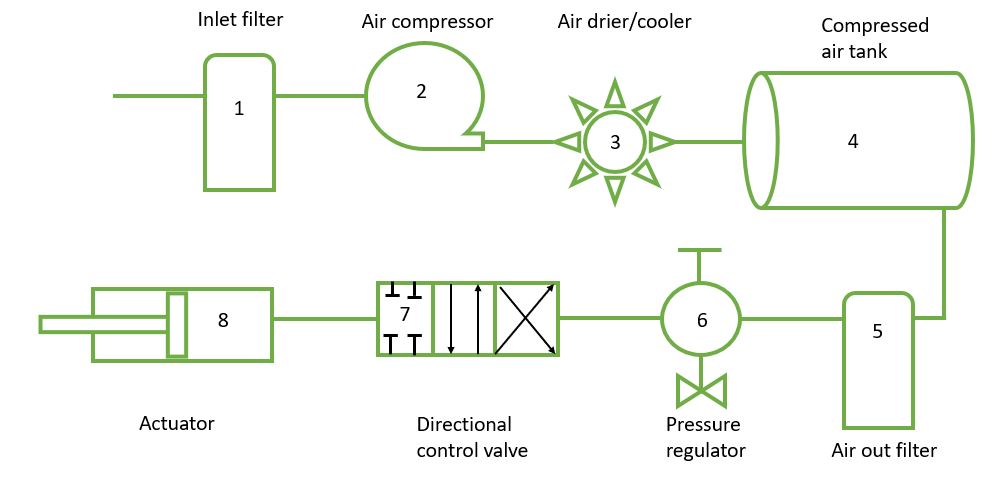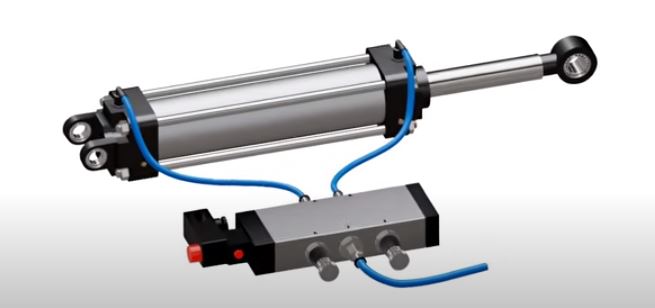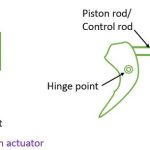Pneumatic systems play a crucial role in various industries, providing a reliable and efficient means of power transmission and control. These systems utilize compressed air to generate mechanical motion, making them versatile and widely employed in manufacturing, automotive, and countless other applications.
This article aims to explore the working principles of pneumatic systems, their key components, and their significance in modern engineering.
What is Pneumatic System
A pneumatic system is a type of power transmission system that uses compressed air to transmit and control energy. It relies on the principles of fluid dynamics and the properties of gases, particularly air.
Pneumatic systems are commonly used in various industrial applications for tasks such as powering tools, controlling machinery, and performing automation processes.
How Pneumatic Systems Work
At the heart of any pneumatic system lies the concept of utilizing compressed air to perform mechanical work. Compressed air is generated by a compressor, typically powered by electricity.
The compressor pressurizes atmospheric air, storing it in a reservoir or tank. This compressed air, under pressure, is then directed to various pneumatic components to execute specific tasks.
Key Components of a Pneumatic System

Compressor:
The compressor is the starting point of a pneumatic system. It draws in atmospheric air and compresses it, increasing its pressure and reducing its volume. Compressors come in various types, including reciprocating, rotary, and centrifugal, each suitable for specific applications.
Air Reservoir:
Also known as an air tank, the reservoir stores the compressed air, acting as a buffer to maintain a consistent air supply. It helps to smooth out fluctuations in demand and ensures a steady flow of air to the pneumatic components.
Pressure Regulator:
The pressure regulator controls the air pressure delivered to different components. It allows the user to adjust and maintain the desired pressure level, ensuring optimal performance and preventing damage to sensitive equipment.
Directional Control Valves:
These valves manage the flow of compressed air to different actuators and control the direction of motion. There are various types of directional control valves, such as spool valves and poppet valves, each serving specific purposes in the system.
Actuators:
Actuators convert the energy from compressed air into mechanical motion. Common types include pneumatic cylinders and rotary actuators. Pneumatic cylinders, resembling hydraulic cylinders, extend or retract based on the air pressure applied.
Filters:
Filters remove impurities and contaminants from the compressed air to ensure the smooth operation of the system. They protect components such as valves and actuators from damage caused by debris and particles.
Hoses and Pipes:
Hoses and pipes transport the compressed air between the various components of the pneumatic system. They must be appropriately sized and durable to withstand the pressure and ensure efficient air flow.
Applications of pneumatic system
Pneumatic systems play a crucial role in modern technology, offering versatile solutions for a wide range of applications across various industries. Here are some common applications of pneumatic systems in modern technology:
1. Manufacturing and Automation:
Pneumatic systems are extensively used in manufacturing and automation processes. They power various tools and equipment, such as robotic arms, pick-and-place systems, and conveyor systems. The precise control and rapid response of pneumatic actuators make them ideal for tasks requiring speed and accuracy in production lines.
2. Material Handling:
Pneumatic systems are employed in material handling equipment, including lifts, clamps, and grippers. The ability to generate considerable force and control it accurately makes pneumatic systems suitable for tasks such as lifting, moving, and positioning heavy loads.
3. Automotive Industry:
Pneumatic systems are widely utilized in the automotive industry for applications like brake systems, suspension systems, and tire changers. Pneumatic tools, such as impact wrenches and air compressors, are commonly used in vehicle manufacturing and repair.
4. Medical Devices:
Pneumatic systems find applications in various medical devices, such as dental chairs, surgical tools, and patient lifts. The precise control offered by pneumatic components is crucial in medical equipment where accuracy and reliability are paramount.
5. Aerospace Industry:
Pneumatic systems are used in aircraft for tasks like actuating landing gear, controlling flaps, and powering various mechanisms. Their lightweight design and ability to function in extreme conditions make them suitable for aerospace applications.
6. Mining and Construction:
Pneumatic tools are prevalent in the mining and construction industries due to their reliability and robustness. Jackhammers, rock drills, and concrete breakers are examples of tools powered by compressed air in these sectors.
7. Packaging Industry:
Pneumatic systems are essential in packaging machinery, where they are used for tasks like sealing, labeling, and sorting. The precise control and rapid response of pneumatic actuators contribute to the efficiency of packaging processes.
8. Textile Industry:
Pneumatic systems are employed in the textile industry for tasks like yarn spinning, weaving, and material handling. Pneumatic actuators provide the necessary control for the precise movement of textile machinery.
9. Chemical and Process Industries:
Pneumatic systems are used in chemical plants and process industries for controlling valves, regulating flow, and automating various processes. Their ability to operate in hazardous environments, where electrical systems may pose a risk, is a significant advantage.
10. Entertainment Industry:
Pneumatic systems are utilized in the entertainment industry for special effects, stage automation, and animatronics. The precise control and quick response of pneumatic actuators contribute to creating dynamic and engaging experiences in theaters and theme parks.
In summary, the applications of pneumatic systems in modern technology are diverse, ranging from manufacturing and automotive to medical devices and entertainment. The reliability, cost-effectiveness, and versatility of pneumatic components make them valuable in various industries, contributing to the efficiency and automation of numerous processes.
Advantages and disadvantages of pneumatic system
Pneumatic systems offer several advantages and disadvantages, and the suitability of such a system depends on the specific requirements of the application. Here’s an overview of the pros and cons of pneumatic systems:
Advantages of Pneumatic Systems
1. Cost-Effective:
Pneumatic components are often more economical compared to their hydraulic or electric counterparts. The simplicity of design and widespread availability contribute to lower overall costs.
2. High Power-to-Weight Ratio:
Pneumatic systems can provide a high power-to-weight ratio, making them suitable for applications where weight is a critical factor, such as in mobile and aerospace applications.
3. Simple Design and Installation:
Pneumatic systems are relatively simple to design and install. The components are modular, and the system is easy to set up, requiring less complex infrastructure compared to some other systems.
4. Fast Response and High Speed:
Pneumatic systems can respond quickly to input signals, making them suitable for applications requiring rapid and precise movements. They are often used in high-speed automation processes.
5. Durability in Harsh Environments:
Pneumatic systems can operate in harsh environments, including high temperatures, explosive atmospheres, and corrosive conditions, where electrical systems might be less suitable.
6. Overload Safety:
Pneumatic systems can handle overloads without damage. When excessive force is applied, the system simply stalls, reducing the risk of damage to components.
7. Adjustable Force and Speed:
The force and speed of pneumatic actuators can be easily adjusted by regulating air pressure, providing flexibility in various applications.
8. Low Maintenance Requirements:
Pneumatic systems generally have lower maintenance requirements than some other systems. Regular checks on filters and lubrication can keep the system running smoothly.
Disadvantages of Pneumatic Systems
1. Limited Energy Efficiency:
Pneumatic systems can be less energy-efficient compared to electric systems, especially in applications with high duty cycles. Some energy is lost as heat during the compression of air.
2. Compressor Power Requirements:
The compressor, a crucial component of pneumatic systems, requires electrical power. While the pneumatic tools themselves may be powered by compressed air, the overall system relies on external energy sources.
3. Air Compression Noise:
The compression of air in a pneumatic system generates noise, which can be a concern, particularly in applications where a quiet environment is essential.
4. Limited Precision:
Pneumatic systems may have limitations in terms of precision compared to some other systems, making them less suitable for applications requiring extremely accurate and controlled movements.
5. Air Leakage:
Pneumatic systems are prone to air leakage, which can impact overall system efficiency. Regular maintenance and leak detection are necessary to address this issue.
6. Limited Energy Storage:
Compressed air storage is limited, and the availability of energy in a pneumatic system depends on the size of the air reservoir. This limitation can affect the system’s ability to handle peak loads.
7. Temperature Sensitivity:
Pneumatic systems can be sensitive to temperature changes, affecting air density and, consequently, the system’s performance. Extreme temperatures may require additional measures for consistent operation.
8. Limited Speed and Force Range:
While pneumatic systems are suitable for high-speed applications, they may not provide the same range of force as hydraulic systems in certain scenarios.
In conclusion, pneumatic systems offer numerous advantages, such as cost-effectiveness, simplicity, and durability in harsh environments. However, they also come with limitations, including energy efficiency concerns and limited precision, which should be carefully considered when selecting a system for a specific application.
Conclusion
Pneumatic systems are integral to modern industrial automation, providing a reliable and efficient means of power transmission and control. Understanding the working principles and components of these systems is essential for engineers and technicians working in diverse fields.
As technology continues to advance, pneumatic systems are likely to evolve, maintaining their relevance in various industrial applications.



3 thoughts on “Powering Industry: An In-Depth Look at Pneumatic Systems”
Comments are closed.